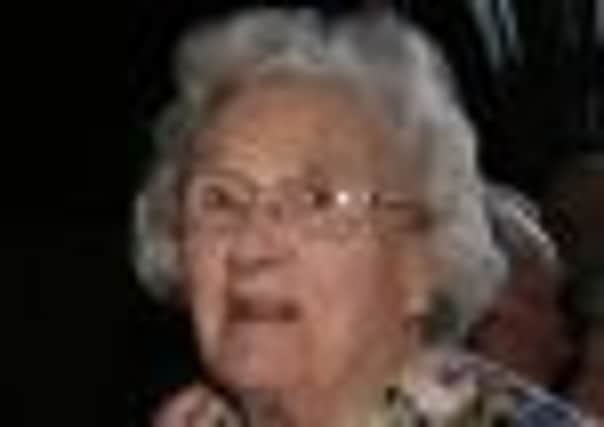Obituary: Vicountess Whitelaw of Penrith, former ATS volunteer who, as wife of Tory MP, devoted herself to charity campaigns


Lady Celia, Viscountess Whitelaw, was best-known as the self-effacingbut staunchly-supportive wife of Willie Whitelaw MP, former Home Secretary, Deputy Prime Minister and trusted aide to Margaret Thatcher. But she was highly active in her own right, campaigning for her husband and the Conservatives and supporting countless charities, not least in Cumbria where the couple spent much of their lives when he was MP for Penrith and The Border.
From their long-time country home, Ennim, outside the village of Great Blencowe near Penrith, she worked tirelessly for the Cumbrian branch of the Barnardo’s children’s charity, the Women’s Institute, the British Red Cross (she was its president in Cumbria), the Eden Valley hospice in Carlisle for those with terminal or life-limiting illnesses, and the Yellow Brick Road Appeal of the Children’s Foundation. She was also a devoted and gifted gardener and a lover of dogs and thoroughbred horses, a lifelong follower of the Cheltenham Festival and a member and familiar figure at Carlisle racecourse.
Advertisement
Hide AdAdvertisement
Hide AdWhile her fiancé and later husband was away at war as a major in the Royal Scots Guards – where he won an MC for bravery – young Cecilia (her birth name, although it was later shortened to Celia) also did her bit for the war effort at home, serving as a clerk for the women’s Auxiliary Territorial Service (ATS) at Edinburgh Castle.
Cecilia Doriel Sprot was born in the family mansion on the Riddell Estate, Lilliesleaf, near Melrose, on New Year’s Day 1917 to Major Mark Sprot of the Royal Scots Guards and Meliora Hay. She was brought up to the sound of hooves and the shooting of pheasants and partridges. Her primary schooling was from governesses at home but she finished her education at the newly-opened Oxenfoord Castle girl’s boarding school at Pathhead, Midlothian, now no longer a school but a well-known venue for weddings and other events.
From the age of nine, she had known a boy called William Whitelaw, who, although he was born in the north-east of Scotland, was a regular visitor to his family estates farther south and was later invited regularly to shoot or attend Celia’s mother’s tea parties in the Riddell mansion house.
Along with her childhood friend and fellow land-owning Scottish Borderer Meg Egerton (later Lady Meg Colville), Celia volunteered for the women’s ATS in Kelso. Fitted out with tailored uniforms, the two young debutantes were posted to Edinburgh Castle as clerks at the ATS Scottish Command where Celia recalled her friend Meg, when asked by a promotion board what her duties were, replying to great laughter: “I type all morning and rub out all afternoon.”
The two friends would later lead the ATS along Princes Street to The Mound on VE-Day and Meg would go on to be lady-in-waiting to the young Princess Elizabeth (the future Queen) and, many years later, to the Queen Mother.
Their exploits in the ATS were mentioned in the book Debs At War 1939-1945: How Wartime Changed Their Lives, by Anne De Courcy.
While on leave from the front, the young squire Willie Whitelaw, with what were once described as “his soulful oyster eyes”, again met Celia. They got engaged in 1942 and married in St Giles’ Cathedral, Edinburgh, on 6 February, 1943. After Willie survived heavy combat during the war, witnessed the horrors of Belsen and returned to civilian life, Celia played an active role in helping him run his family estates in Dunbartonshire and Lanarkshire. When he decided to go into politics in the 1950s, she became first a vivacious campaigner and later an active parliamentary wife. Although he won an image of “a pleasant, bumbling old Tory duffer”, Willie Whitelaw was politically razor-sharp and Celia’s behind-the-scenes support helped ensure that he became respected, even loved, across the political spectrum.
She was by his side when he won the seat for Penrith and The Border, including Carlisle and stretching close to Gretna Green, in 1955, a seat he held for nearly 30 years. She was by his side during one of his happiest moments, being named Captain of the Royal and Ancient in 1969. She was never far from his side when he was in Cabinet, including as the first Northern Ireland Secretary under Edward Heath, later as deputy and right-hand man to Margaret Thatcher, who once famously said: “Every prime minister needs a Willie.”
Advertisement
Hide AdAdvertisement
Hide AdWhen he became Viscount Whitelaw in 1983, Celia became Viscountess Whitelaw of Penrith and lovingly cared for their gardens, including fruit and vegetables, at Ennim, their country house near the Cumbrian town. She served on the Lakeland Horticultural Society and was vice-president of Penrith and District Gardeners’ and Allotment Holders’ Association.
After her husband suffered a series of strokes from 1987, Lady Celia cared for him. When he died in 1999, she sold Ennim and moved across the Border to be closer to one of her daughters, Mary, at Haystoun farm near Peebles, where she proceeded to build up another beautiful garden while Mary and her husband David (who died in June this year) ran a full-time cattle and sheep farm and a shooting and fishing estate, which brought back memories of her childhood. It also meant she was again close to her two dear bachelor brothers, Jock (who died last year, aged 99) and Aidan, now 92.
Viscountess Whitelaw is survived by her daughters Elizabeth, Carolyn, Mary and Pamela and 12 grandchildren, as well as brother Aidan.
Her funeral will be held tomorrow at her old church, St Andrew’s in Dacre, Cumbria, where her husband is buried.
Phil Davison